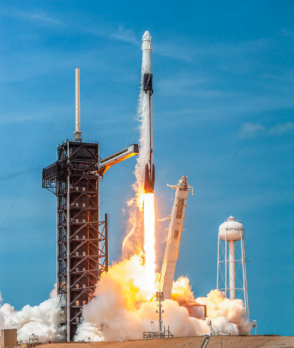What is very interesting is the pad that launched the recent Dragon capsule is the same pad that was used back in the sixties for the Apollo missions and the space shuttle launches that came after. There is a lot of history in that one small site and was therefore fitting that the first launch of Americans from US soil since 2011 took place from this launchpad, where all those who have come before launched from themselves.
This trip however, was one that had been in the making for some time. Before they were able to launch such a momentous rocket, there had to be a significant number of tests done to ensure that it was safe to send astronauts up within it. This is why only last year, it was sent up unmanned with only a dummy inside.
 This success proved that it could make the journey in a safe manner, but was in itself, not the start of it's story.
This success proved that it could make the journey in a safe manner, but was in itself, not the start of it's story.Before looking at the history of the capsule and the steps that SpaceX went through to make this launch happen, the capsule itself is a significant change from the history of US space capsules which had not been used since the end of the Apollo program. The astronauts this time around had access to touch screen panels which would not have looked amiss on the Kelvin Enterprise and space suits which looked more futuristic than the classic bright orange suits we saw through the space shuttle era. It is clear that SpaceX was going for a very functional, but futuristic design with the Dragon capsule. Another one of the interesting notes is the name that the astronauts chose for this capsule, Endeavour, was named after the shuttle both men served on, but was also a nod to the endeavour that Nasa and SpaceX have embarked on as part of this mission itself.
This pinnacle of technology was sitting atop the only reusable rocket which has been developed in the world, however the one used to send up this mission was on it’s first mission of use, but it is likely that it’ll be reused sometime in the future as they were able to recover it on the drone platform.
The Falcon rockets are only planned to send crews and payloads into Earths orbit. Further travel will begin with the production of the SpaceX Spaceship, which was developed as a way of getting around the idea of trying to recover the second stage of a rocket. This is due to a number of reasons, the primary of which is the speed of which it enters the atmosphere, as they travel at orbital velocities.
There is already another launch planned for the new Dragon capsules with this next one will carrying four astronauts up to the International Space Station to make up the Expedition 64 crew. This is scheduled for the 30th August 2020 although will be dependent on a number of factors in the future.
Looking back, the Falcon rockets themselves have had an impressive history with 86 launches to date with only a single total failure and a single partial failure. Both of these failed missions were resupplies for the ISS with the last one happening back in 2015. With just under five years of an impeccable record, it has become one of the most dependable rockets with only a handful of other rockets having launched as many missions.
Overall, SpaceX has been able to bring a new light to space travel as they broadcast a significant number of launches that they do, and are potentially sparking an interest in space travel for a brand-new generation.
They have ambitious plans for the future with their eye on Mars with each step of development they make, being a smaller part of the long-term goals that they have. Hopefully in the next few years, we will see Starship start to make an appearance and show us how reusable a space program can really be, and how far it can take us.
Is Private Industry the best hope for continued space exploration? Let us know in the comments below.
WRITTEN BY Chris Wilkinson
EDITED BY Silek



